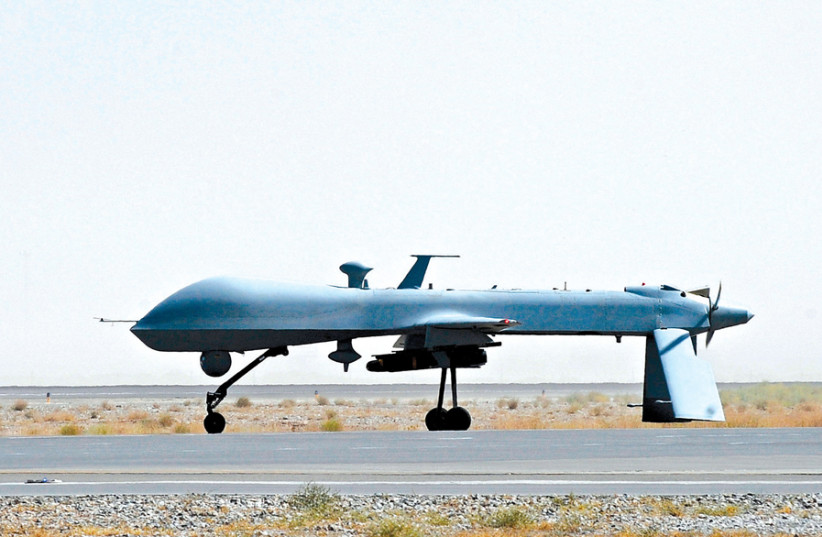Iran claimed that a US Reaper and Global Hawk drone approached Iran’s airspace during a recent drill and that Iran switched on its sophisticated air defenses to warn the drones not to continue on their flight path. According to Iran’s Fars News, which generally represents the regime, the incident took place as Iran was carrying out its Zulfiqar army drill. An MQ-9 Reaper and MQ-4 Global Hawk were noticed by Iranian radar apparently entering the “air defense identification area.”
While they were under full observation of the country's integrated air defense network from miles away…they were intercepted by the army air defense and faced a serious warning,” Iran’s media says. The report notes that the UAVs, which have a flight range of thousands of kilometers, “changed their route from approaching the borders of the Islamic Republic of Iran after the air defense was determined to intercept and warn.”
The Global Hawk is a large whale-like US surveillance drone. Iran shot one of them down in June 2019 during growing tensions. The drone is estimated to cost between $100 and $200 million dollars, depending on its configuration. It can be configured as a Triton model or a BAMS-D version which carries out broad area maritime surveillance. The Reaper by contrast can be armed and is similar to a US Predator. Both drones have origins in the 1990s and have been flying for decades and play a key in the US Global War on Terror. Both are too slow for modern-day-- air defenses and can be seen on radar, like the type Iran uses with its 3rd Khordad air defense system. US armed and surveillance drones are generally not well suited for contested air space, one of the problems that US drone programs have faced as the US transitions to deal with near-peer rivals, or even regional powers like China.
The US has other stealthy spy drones. Iran was able to intercept one of those, the RQ-170 Sentinel, and bring it down over Iran in 2011. The embarrassing incident led to the US asking for the drone back. Iran didn’t return the flying-wing-like drone and instead reverse engineered it and made a bunch of its own drones based on the US model.
Iran helped the Houthi rebels target and apparently shoot down US Reaper drones over Yemen in June and August 2019. At the time it was not clear how the Houthis obtained the ability to target US drones but Iran has been supplying the Houthis with missiles and drones since 2015.

The US in 2019 accused Iran and Iranian-backed Houthi rebels of firing surface-to-air missiles at American Reaper drones twice in June. One incident took place on June 6. Iran often tracks US military and navy flights in the Gulf. Iran said it tracked a P-8 during the shootdown of the Global Hawk in June 2019. It also likely tries to track US Reaper and Global Hawk flights out of Al-Dhafra base in the UAE. Iran has also used its own drones to fly over US carriers and harass US ships. In July 2019 a US ship, the USS Boxer, downed an Iranian drone that was harassing the ship. In July 2021 Iran used a drone to attack a commercial tanker in the Gulf of Oman, killing two crew members. Iran claimed in early November that it sent a helicopter to raid an oil tanker and prevent US “piracy” in the Gulf.
The recent Iran Zulfiqar exercise included the use of drones and also practice with the army. Iran says its flew Mirage and F-4 fighters during the drill, as well as P-3 reconnaissance aircraft. The Mirage fighters were apparently those Iran got from Iraq in the 1991 Gulf War when the Iraqi air force flew craft to Iran to avoid destruction. The F-4s are American craft sold to the Pahlavi regime in the 1970s. Iran also says it used naval helicopters and tanks in the recent drill. Admiral Amir Seyed Mahmoud Mousavi, the spokesman of the Zulfiqar 1400 joint exercise, announced that: "This exercise was held with the implementation of various military scenarios in the operational area with an area of more than one million square meters."
The objective of the drill was to improve Iran’s abilities along the coast. It was also practicing to operate further from the coastline. This included the use of drones and evaluations of “accuracy and destructive power of coastal, naval and air-based missile systems.” Iran says it has continued to build new weapons based on local designs. "Also, the manifestation of the military authority as a powerful arm of the holy system of the Islamic Republic of Iran in the southeastern region of the country and ensuring investment security in this region, including our presence in international and distant open waters,” the spokesperson for the drill said.
